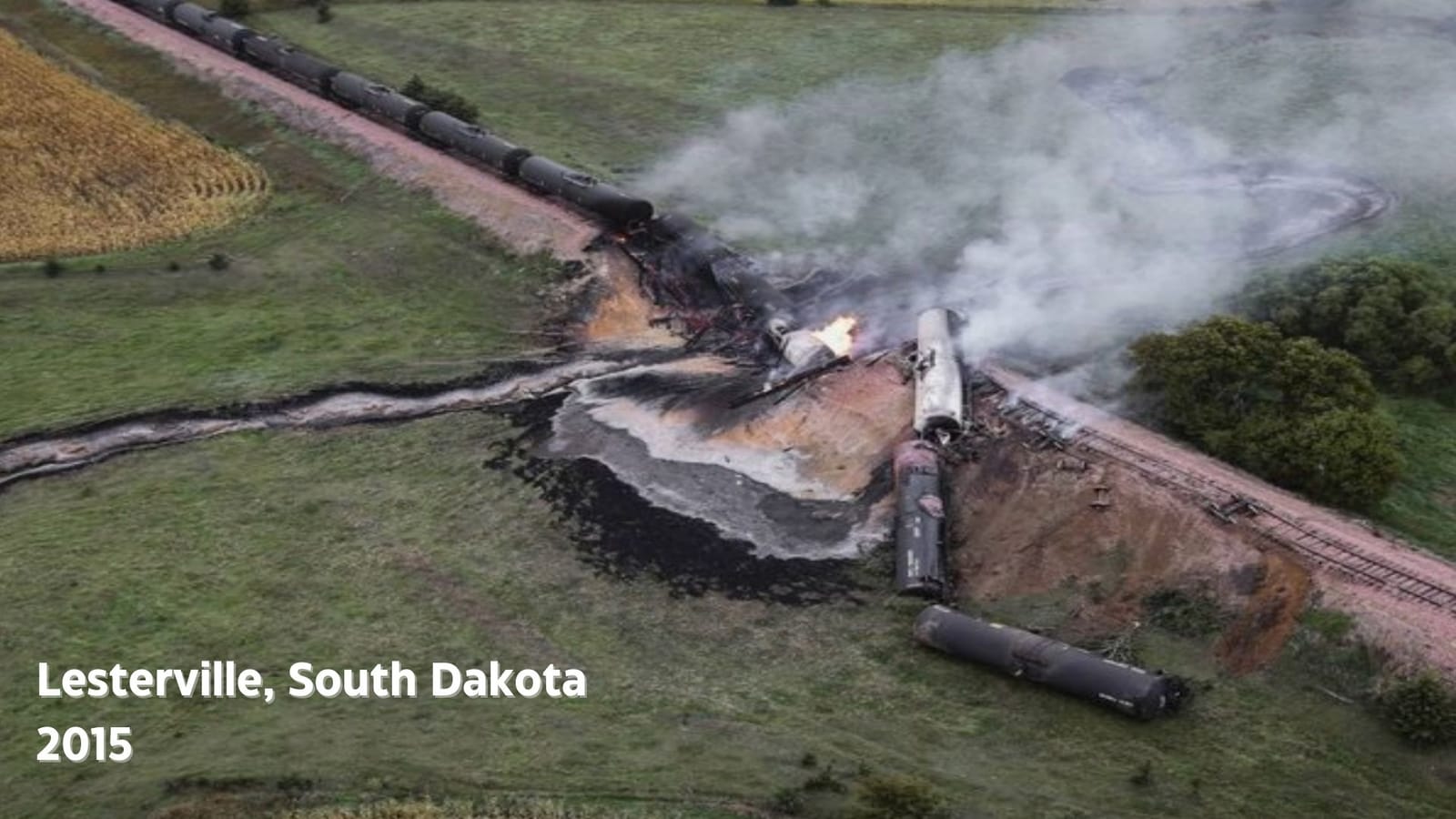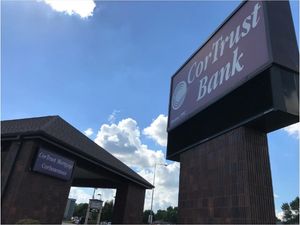Each year, trains carry nearly 11 billion pounds of chemicals through South Dakota’s cities and countryside, much of it on century-old tracks, a South Dakota News Watch analysis has revealed.
Finding out which specific compounds are in those potentially toxic payloads is extremely difficult or even impossible for the public due to national security concerns and secrecy within railroad companies.
In many cases, state and local officials are kept largely in the dark about what materials are being carried through communities and rural areas. Oftentimes, the nature of materials transported becomes known only after an accident.
State and local governments can ask railroad companies for lists of hazardous materials transported through their jurisdictions only if the information would be used to help them prepare for emergencies, but not to inform the public, according to an email from the public affairs department at the Federal Railroad Administration (FRA).
“Neither FRA nor any government agency can provide information that lists specific rail lines that hazardous material shipments traverse, as railroads consider such information to be proprietary, and doing so raises safety and security issues,” the office said. “In addition, as a federal safety regulator, FRA does not monitor train movements or types of cargo transported by private rail companies in real time.”
Concerns over the stability, security and safety of the U.S. railroad system took on greater significance after a catastrophic derailment and fire on Feb. 3 in East Palestine, Ohio.
The accident was caused by a worn-out wheel bearing on a rail car, the same condition that prompted 17 freight cars to derail at 40 mph near Wessington, South Dakota, on Feb. 2, 2019, according to federal records.
The toxic chemical burned in the Ohio accident, vinyl chloride, which is used to make plastics, is part of the larger category of chemicals that can be carried by trains in South Dakota but which is not reported to the public.
Chemicals are fourth most carried products on trains in South Dakota
Some Great Plains states, such as Minnesota and Wyoming, report on the total tonnage of hazardous materials carried by rail in their states, but South Dakota does not.
The South Dakota State Rail Plan, a 182-page overview of the state railroad system, includes information on 15 categories of materials carried by rail but not on hazardous materials.
The report includes a final category listed as “all other commodities” that shows about 160 million pounds of materials carried, without providing specific or general product details.
More from News Watch: SDSU, USD rely heavily on state money to Division I athletics
In South Dakota, “chemicals or allied products” are the fourth most-carried product by railroads based on tonnage after coal, farm products and food products, according to the 2022 State Rail Plan, which was updated in December for the first time since 2014.
The rail plan shows data on the tonnage of products carried in 2019 and is based on federal Surface Transportation Board “waybill reports.” In South Dakota that year, the payload category of “crude petroleum, natural gas or gasoline” was next in tonnage after chemicals, totaling 7.3 billion pounds carried annually.
Train payloads may be radioactive or used in chemical warfare
According to federal documents, the general payload category of “chemicals and allied products” can also include chemicals and products such as anhydrous ammonia, chlorine, human and animal medicines, pesticides, inks and dyes, and even radioactive compounds or those used in chemical warfare.
In an email response to questions, Jack Dokken, the air, rail and transit program manager for the South Dakota Department of Transportation, said the federal government is responsible for regulating rail shipments in South Dakota, but the state can respond to a release of hazardous materials. DOT officials did not respond to News Watch requests for an interview.
“The Department of Agriculture and Natural Resources can become involved if a hazmat release has occurred,” Dokken wrote. “DANR has authority to require the responsible party to perform cleanup and DANR reviews cleanup activity to ensure compliance with state laws and rules.”
Transportation officials from North Dakota and Wyoming told News Watch they have little knowledge about what chemicals and hazardous materials private railroad companies are carrying through their states.
“At a guess, petroleum, natural gas, and anhydrous ammonia are probably in our top three for hazmat, but after that it’s anyone’s guess – and I have no idea on volumes or routes being used,” said Stewart Milakovic, North Dakota DOT transportation planner.
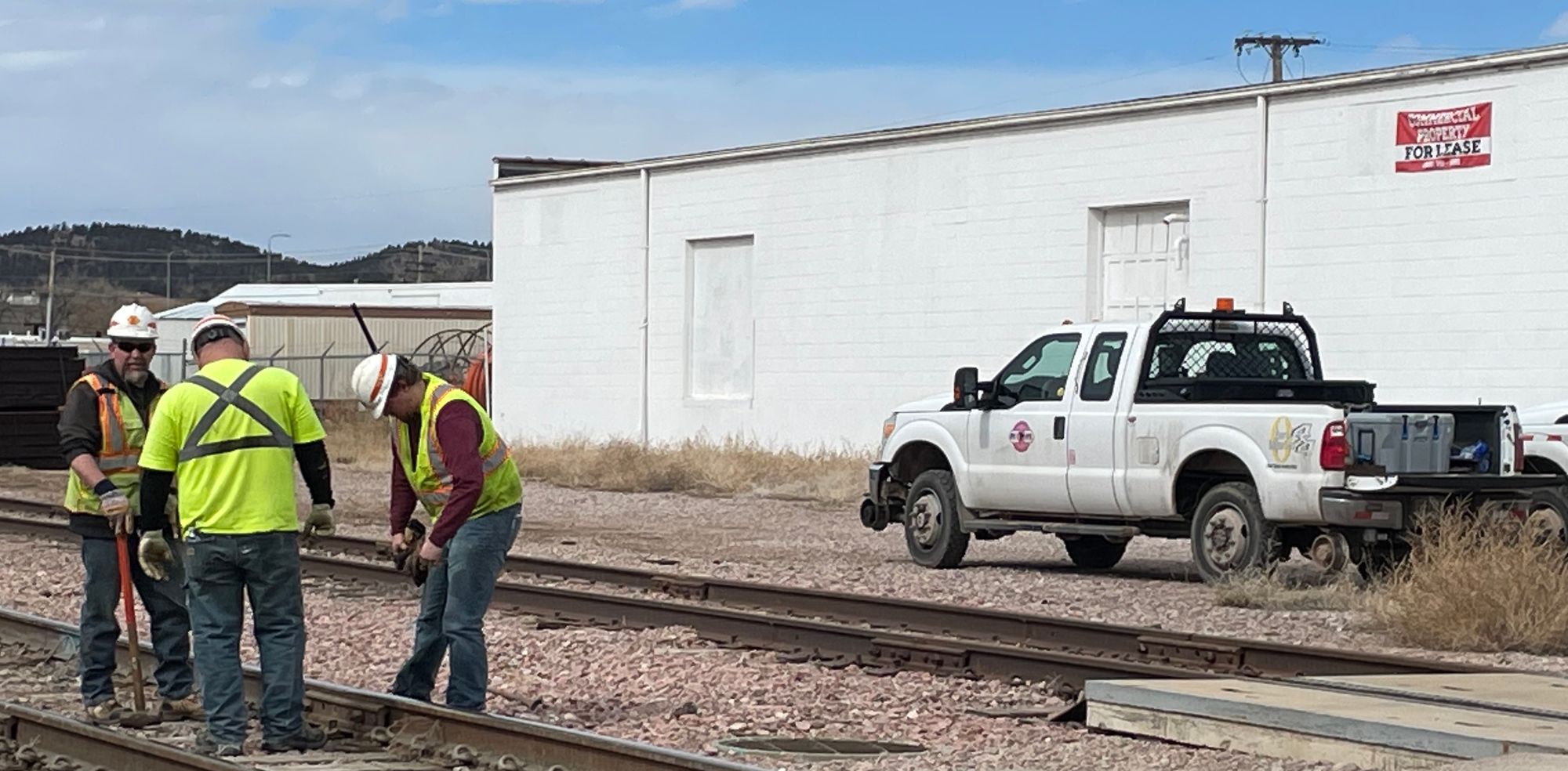
The FRA said that in response to the Ohio accident, Transportation Secretary Pete Buttigieg called on railroad companies to be more proactive in letting states know when toxic materials are being transported in their area. Across the U.S., hazardous materials were the second-most commonly transported material by rail from 2019-21 based on tonnage, with 218 million tons carried in 2021 alone, according to the federal Surface Transportation Board.
“Secretary Buttigieg called on U.S. railroads to provide proactive advance notification to state emergency response teams when they are transporting hazardous gas tank cars through their states instead of expecting first responders to look up this information after an incident occurs,” the department wrote.
South Dakota News Watch has filed formal Freedom of Information Act requests to the South Dakota Department of Transportation and the Federal Railroad Administration seeking data on chemicals and hazardous materials carried in the state, but had not received a response as of December 2023.
Railroad expert says it’s like putting a Band-Aid on a broken bone
South Dakota has 1,935 miles of railway operated by 11 private companies, with BNSF Railway, Rapid City, Pierre & Eastern Railroad (RCPE) and Ringneck & Western Railroad (RWRR) the top three operators. The state does not have any passenger trains in operation other than the historic limited-route tourist train in Hill City.
The rail plan includes estimates showing that tonnage of materials transported by rail in South Dakota could increase by 34% from 2019 to 2045, including an expected 31% rise in the amount of chemicals transported.
While U.S. per-mile safety data show that rail generally remains a relatively safe method of transportation of goods, rural states like South Dakota tend to have aged rail systems, with infrastructure sometimes built in the late 1800s or early 1900s, said Russell Quimby, an Omaha, Nebraska-based railroad expert and industry consultant.
Some railroad lines, especially shorter branch lines that are common in South Dakota, are not well-equipped to handle modern rail cars that weigh up to 286,000 pounds each and are part of increasingly longer trains, he said.
Additionally, some older rail lines have not had adequate reinvestment by railroad companies as they endured thinning profit margins in recent decades.
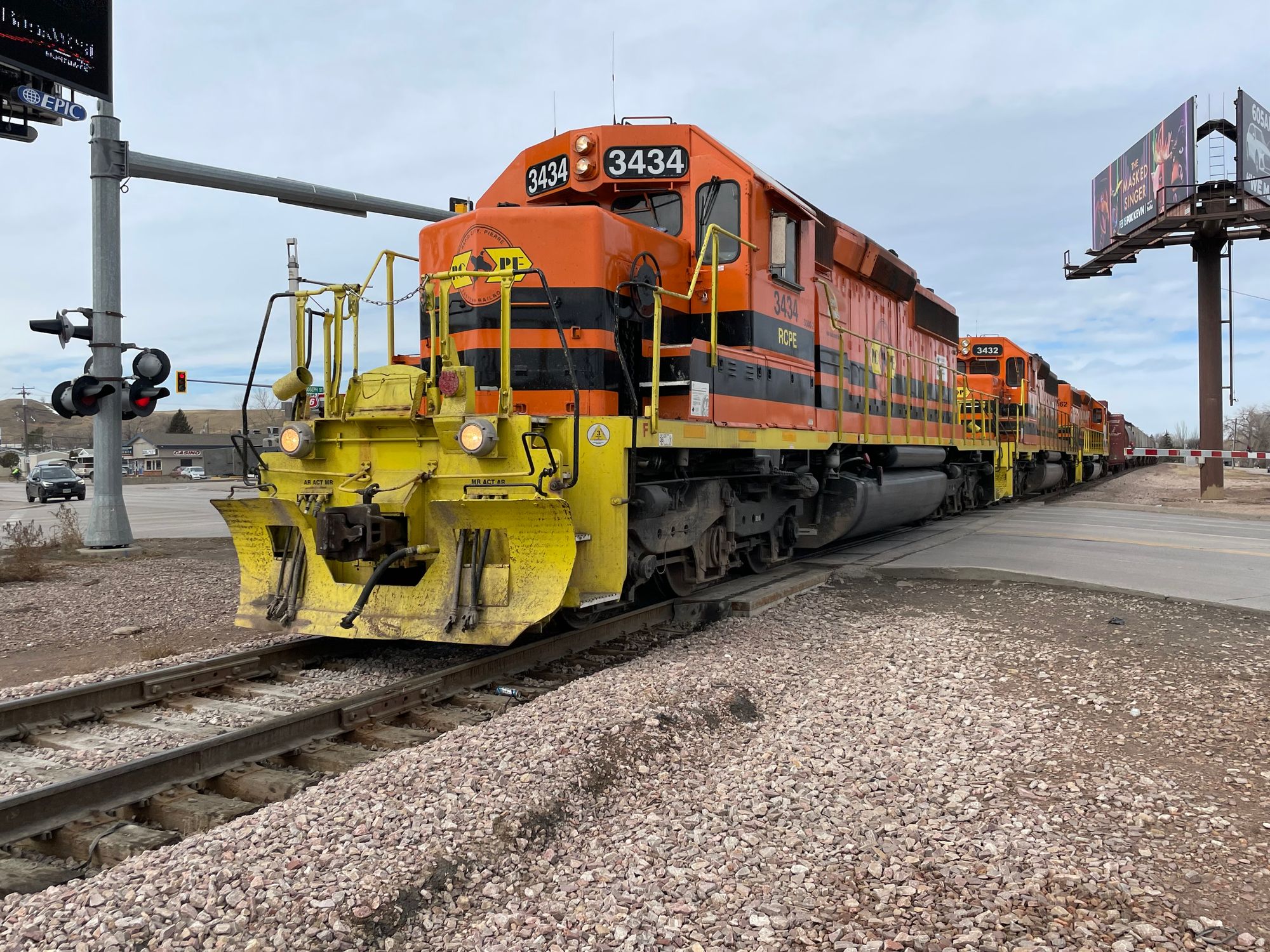
“They’re barely able to do things safely in some cases,” Quimby said. “Even if you identified all these defects in the track, does the company have enough money to fix things properly? They may put a Band-Aid on it when they really should be treating a broken bone.”
The increased focus on rail safety in the U.S. also comes at a time when the railroad industry is staffed in some cases by employees who are vastly overworked, he said.
A nationwide railroad worker strike was narrowly avoided in February after employees complained, in part, that they were underpaid but also were prevented from taking any days off or receiving paid sick time.
Quimby said the railroad industry cut 9% of its workforce in the five years before the COVID-19 pandemic, and now, “the people they have are working to death. They’re cutting all kinds of corners, and after a while, you get employees who are burned out, and that indirectly affects safety, morale and all that.”
More than 110 train accidents in South Dakota since 2012
The railroad system in South Dakota is much smaller than in more industrialized states like Ohio or Pennsylvania. Yet it has shown a propensity for accidents of a wide variety of causes and outcomes, including derailments.
State data show that South Dakota had 105 “incidents and accidents” reported to the FRA from 2012 to 2021, according to the state rail plan. Federal records reviewed by News Watch showed that the state saw another nine accident reports filed in 2022. All told, those accidents resulted in two deaths and 83 injuries among railroad workers, the data show.
Derailments and other railroad incidents have taken place in South Dakota at the rate of roughly one every five weeks over the past six years, according to FRA accident reports reviewed by News Watch.
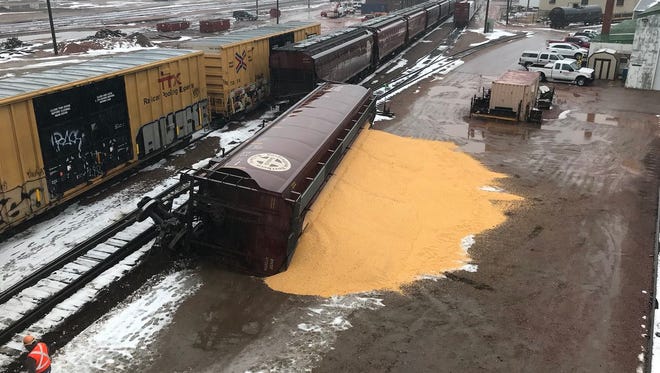
In 60 South Dakota accident reports from 2017-2022, mechanical problems and railroad wear played a role in a number of derailments and accidents:
- On June 26, 2017, six rail cars derailed due to a broken segment of track near Gayville in Yankton County.
- On June 5, 2020, train workers could see the track ahead was misaligned near Harrold in Hughes County, causing eight cars to derail at 24 mph due to soft ground believed to be caused by a muskrat den.
- On Sept. 18, 2022, nine rail cars derailed while traveling at 23 mph near Utica in Yankton County due to missing joint bolts on the rail line.
Those state rail accident reports don’t include accidents that happened at highway rail crossings. South Dakota had 110 railroad crossing accidents over the past decade that resulted in six fatalities, 35 injuries and 69 incidents of property damage, according to state records.
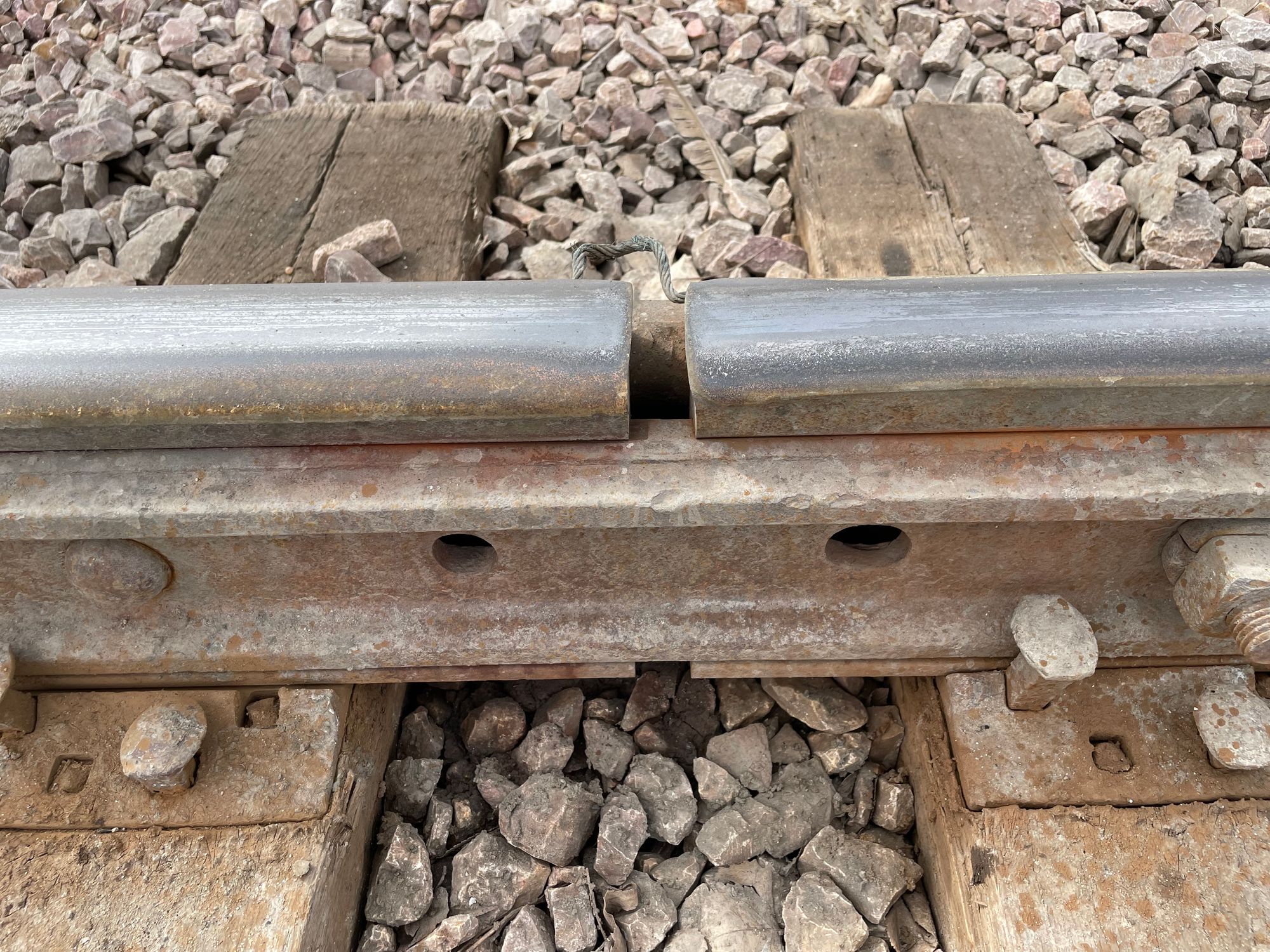
Ethanol explosion in southeast South Dakota caused by worn rail heads
In the state’s most destructive rail accident in recent years, a derailment and explosion of several ethanol cars occurred on Sept. 19, 2015, in a rural area near Lesterville, about 20 miles northwest of Yankton.
Investigators from the National Transportation Safety Board later found that rail heads that carry train wheels were worn beyond safe levels, tracks were out of alignment and safety problems noted by railroad operator BNSF were not repaired but instead allowed to remain when the railroad simply downgraded the technical classification of the rail line.
Records show the section of railroad was built in 1908 and installed in 1929. The wooden railroad bridge where the accident took place was built in 1954.
Even at just 10 mph, seven tanker cars flipped off the rails, and two breached at impact. Nearly 50,000 gallons of ethanol leaked onto the ground and into the bed of Prairie Creek, where it ignited in a wall of flame. No one was injured, but the accident caused $1.1 million in damage.
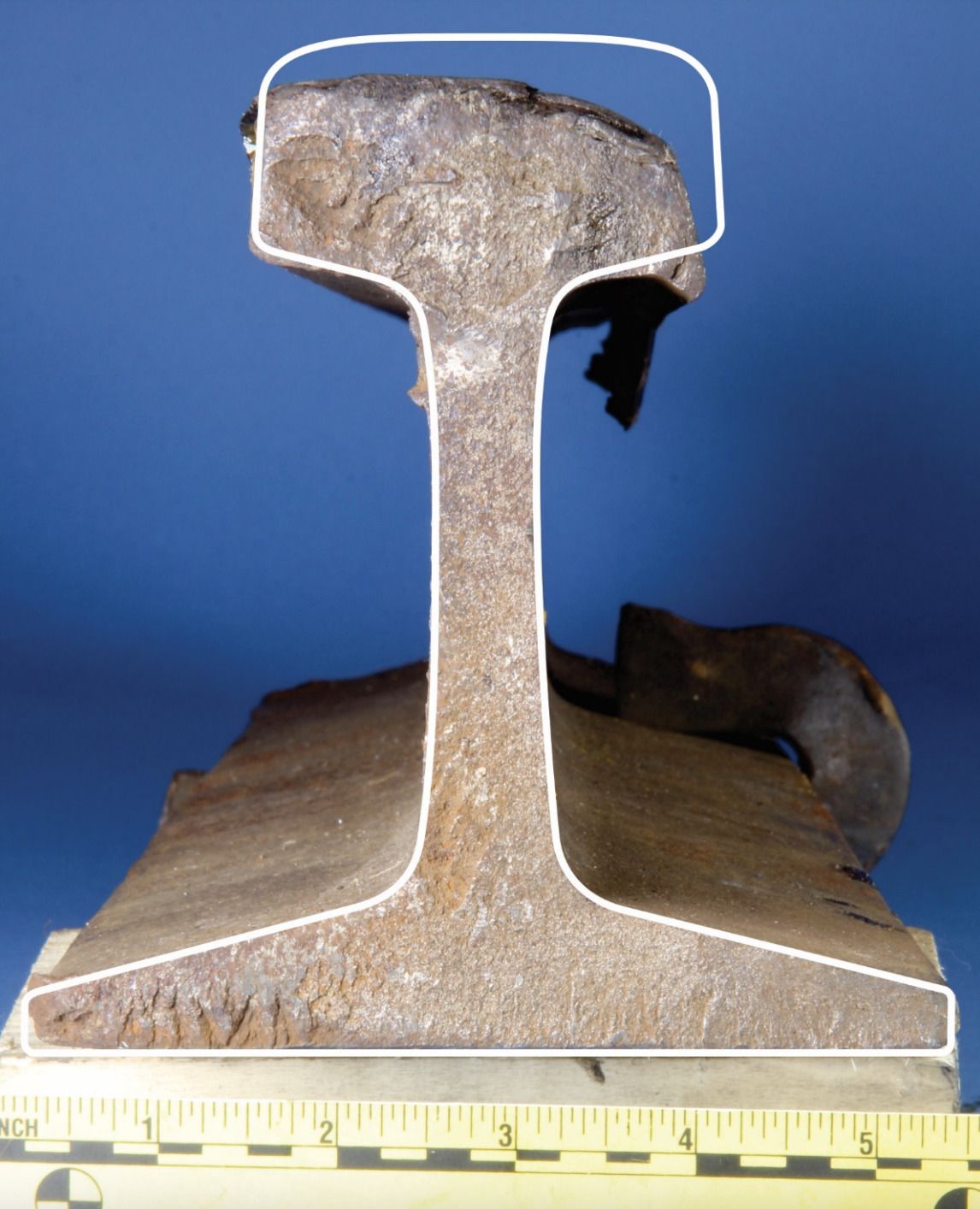
Local farmer Mike Neth told News Watch in 2018 that he had noticed train cars wobbling as they passed through his property prior to the accident.
“It looked like a disaster area, like someone had blown up a town,” Neth recalled. “If it would have happened in a town like Yankton, it would have been a lot worse.”
‘Scary factor’ of spring flooding can cause even more train issues
South Dakota rail carriers are preparing for trouble this year because of the potential for flooding and soft ground.
“We’re starting to plan and get some assets put in place with all the snow coming and the extremely cold temperatures for this time of year,” Mark Trottier, a representative of the Dakota Missouri Valley Western Railroad, told the South Dakota Railroad Board during a March 15 meeting.
“The scary factor of that is we get into April and temperatures start to rise too fast and we get some overland flooding, and so we’re prepping and preparing for any unforeseen issues. We’ll be dealing with some soft spot issues down there and we’ll do everything we can to minimize any issues or problems.”
The DMVW railroad leases part of a state-owned rail line in South Dakota and expects to spend about $65,000 this year to keep its leased lines up to date on railroad ties, a required bridge inspection and weed control.
States have little oversight of rail lines and trains
In general, states have little regulatory authority over rail lines, which are maintained by privately run railroad companies under FRA oversight.
More from SD News Watch: Civil civics: Observers note more positive pulse in South Dakota politics
Dan Kline, the supervisor of systems planning in the Wyoming Department of Transportation, oversees administration of the state’s railroad rail section as well as other functions in the Wyoming DOT. The state freight department has one employee who works to ensure safety at Wyoming’s roughly 400 railroad crossings, Kline said.
The state does not own any railroad track, so the six railroad companies that operate in the state are wholly responsible for oversight, inspection and maintenance of the 1,900 miles of track in Wyoming, Kline said.
Kline said the DOT has no knowledge of what is carried in freight cars and tankers on its railroads beyond what is reported in the 2021 State Rail Plan, a comprehensive report on the state railroad system that is similar in content to the South Dakota State Rail Plan.
Kline said Wyoming hires an independent firm to compile and report federal railroad data, including what commodities, chemicals and hazardous wastes are carried by rail in the state.
State officials never see the original federal data and rely only on what is reported by the contracted consultant, HDR of Denver, he said. The state’s main goal with data in the rail report is to ensure it meets federal government guidelines on what must be reported.
“I would have no idea what any of that is,” Kline said in regard to what specific chemicals or hazmat products are carried on Wyoming rail lines. “Where the highway intersects the railroads is where we get involved.”
Kline said a member of the media or public who wanted to know what products are traveling by rail in Wyoming “could ask the actual railroads, read the placards on the trains or ask the federal government.”
But railroad companies are private entities and are not required by law to provide the public with details on what is carried, when and where, said Tom Ciuba, a spokesman for the Rapid City, Pierre & Eastern railroad.
“For security reasons and to uphold shipper confidentiality, RCPE does not release specifics on our traffic,” Ciuba said in an email to News Watch.
Railroad company says it performs regular safety maintenance
The RCPE railroad mainly carries agricultural products, minerals and stone on its 679 miles of track in South Dakota, Ciuba said.
He noted, however, that all U.S. rail lines are subject to so-called common carrier obligations in which the federal government can require them to carry hazardous materials if needed.
RCPE performs safety checks on its rail lines and equipment as required by federal law and its own internal standards. It considers “derailment prevention critical to that safety focus,” Ciuba said.
The company performs regular maintenance to stay in compliance. And it has a comprehensive emergency response plan that addresses a potential catastrophic incident and reviews the plan regularly, Ciuba said.
RCPE also has contracts in place with companies that are trained in environmental response and incident mitigation, he said.
“Safety is a core value at RCPE, with many employees living directly in the communities we serve,” Ciuba said.
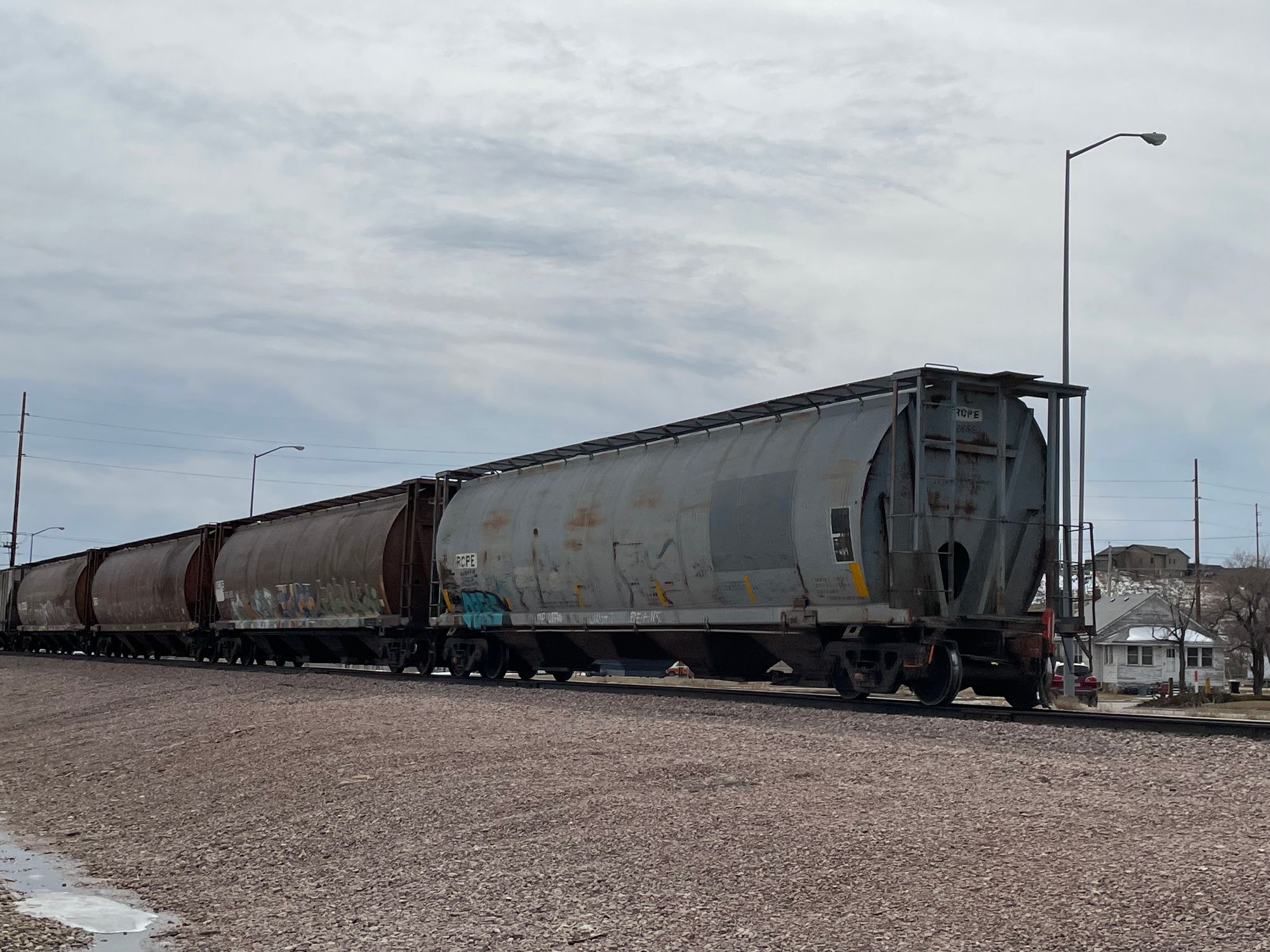
Expert says rail is still safest and cheapest way to ship goods
Quimby, the railroad expert, said that despite recent accidents and a few historic catastrophes, rail remains the safest and most economical way to ship goods, especially when compared to high-risk roadway trucking and cost-intensive pipeline construction.
“They move relatively safely, and compared to any other mode of transportation, you’re probably not going to get a safer way to do it,” he said. “The materials they carry are necessary to our lifestyle and our jobs and our economy, and it’s being moved as safely as humanly possible.”
And yet, Quimby also believes that safety must remain a top concern because accidents can and will happen in anything involving humans and machines.
“Now, does that mean a one out of a million thing couldn’t happen and affect you? he asked. “No, but you’re much more likely to get killed on the highway driving.”
Materials carried by railroads in South Dakota
Here is a look at the 10 most common types of materials carried into, out of, within or through South Dakota in calendar year 2019 by tonnage. Weights are shown in tons.
Category — Tons
Coal — 80,444,000
Farm products — 11,137,000
Food/Kindred — 6,993,000
Chemicals/Allied — 5,492,000
Crude petro/gas — 3,323,000
Petro/coal prod. — 2,226,000
Clay/concrete/glass 2,021,000
Logs/lumber/wood — 1,100,000
Non-metal minerals — 933,000
Trans equip — 408,000
Total — 115,197,000
Source: South Dakota State Rail Plan 2022 from 2019 Surface Transportation Board reports

